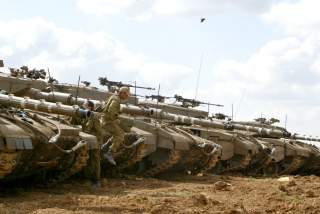Israel's Merkava Tank Is Impressive, But Here's Why Most Nations Haven't Adopted It
Where the ammunition is stored matters.
Key Point: It’s clear why most nations have stuck to more traditional designs instead of embracing the Merkava’s frontal engine tank design.
The Merkava tank is sometimes called the most survivable tank in the world. The reasons given usually include its active protection system, forward engine design, urban warfare specific modifications, and thick armor. But do these claims hold up to scrutiny?
The Merkava was designed in the 1970s following the failure to purchase Chieftain tanks from the United Kingdom. Originally designed to duke it out with Soviet tanks in the deserts surrounding Israel, the tank was laid out in a rather unorthodox manner compared to contemporary Western and Soviet tanks, featuring a design more akin to some infantry fighting vehicles. Instead of having the engine at the rear, the engine was moved in front of the crew compartment, with the turret placed further back on the chassis.
The result was that the front armor could be more gradually sloped, and the crew could enter and exit the tank quickly from the rear.
However, this comes with the drawback of having the engine more easily disabled, as any penetrating front hit will disable it. Israeli doctrine prioritizes the survivability of the crew in an engagement, so in the event of a disabling hit the crew will bail out rapidly through the rear hatch if the situation allows. On the other hand, a penetrating frontal hit on a western tank will likely leave the tank still mobile.
While the question of whether a tank crew would stay in a tank or not after a penetrating hit is up for a lot of debate, there are instances where mobility will increase the survivability of the crew, primarily in a fighting disengagement where the tank might be surrounded. In an engagement where an attack is succeeding (which to be fair to the Israeli Defense Forces, is likely in most of their post-1970s conflicts), the Merkava’s design makes sense, but for a European army expecting to hold against a Soviet or later a Russian advance, a mobility kill might be a far bigger deal.
The other big issue is the storage of the ammunition in the Merkava. Ammo in the Merkava is stored in the crew compartment in flame-resistant plastic containers. While these containers can delay the cook-off of ammunition, Merkavas have suffered catastrophic failures when their ammunition load was hit. The Merkava Mk 4 mitigates this by storing some ammo in the turret with blow-off panels, but this storage can only hold ten rounds. This makes it far less survivable in event of an ammunition hit compared to bustle storage designs such as the M1 Abrams, K2 Black Panther, or Leclerc.
However the position of ammunition in the rear of the hull does make it hard to hit in a frontal engagement and a hit to that area is only likely if the tank is engaged from the side aspect, a deadly situation for almost any tank. The Merkava also mitigates the risk of side shots with modular armor and active protection systems, though these are becoming standard on most modern tanks.
Does all of this mean the Merkava is a poor tank? No. But it’s clear why most nations have stuck to more traditional designs instead of embracing the Merkava’s frontal engine tank design.
Charlie Gao studied Political and Computer Science at Grinnell College and is a frequent commentator on defense and national security issues.
This article first appeared in March 2019. It is being republished due to reader interest.
Image: Reuters.

